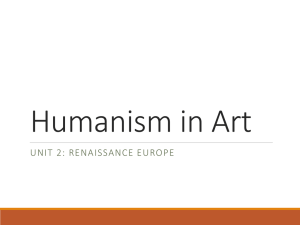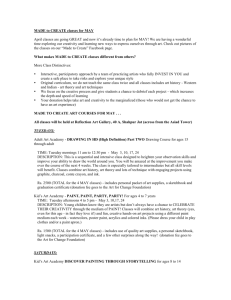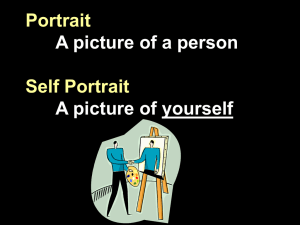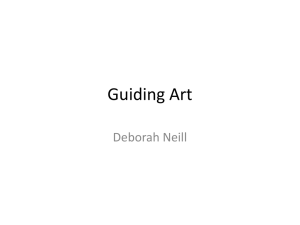Unit 2: The Renaissance
advertisement
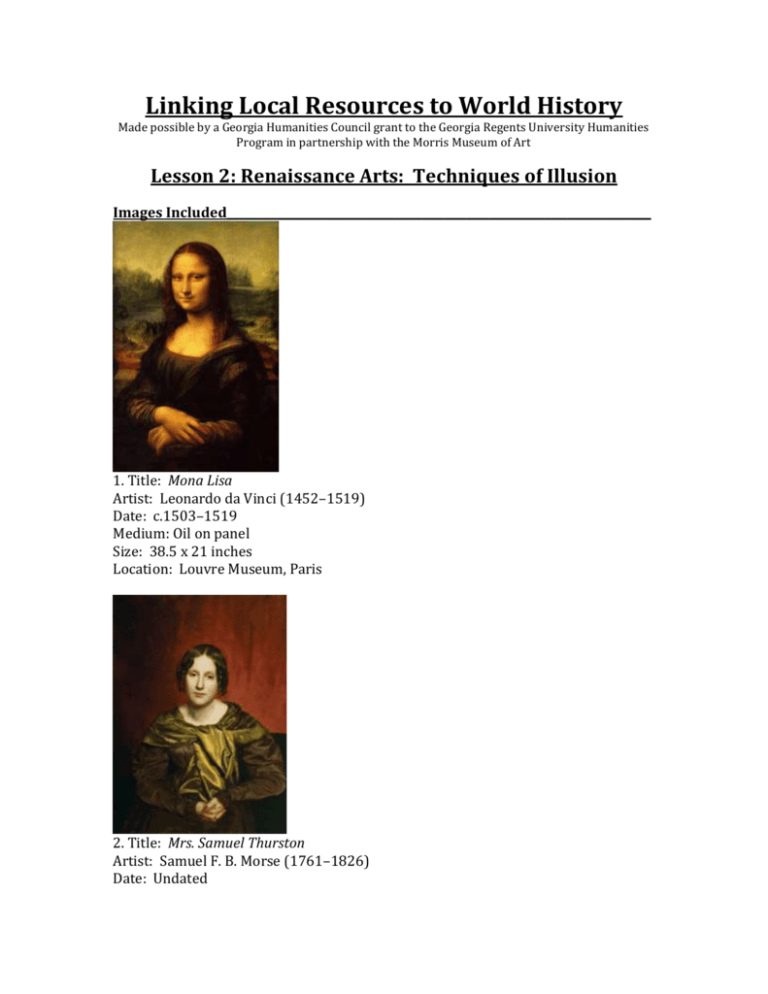
Linking Local Resources to World History Made possible by a Georgia Humanities Council grant to the Georgia Regents University Humanities Program in partnership with the Morris Museum of Art Lesson 2: Renaissance Arts: Techniques of Illusion Images Included____________________________________________________________________________ 1. Title: Mona Lisa Artist: Leonardo da Vinci (1452–1519) Date: c.1503–1519 Medium: Oil on panel Size: 38.5 x 21 inches Location: Louvre Museum, Paris 2. Title: Mrs. Samuel Thurston Artist: Samuel F. B. Morse (1761–1826) Date: Undated Medium: Oil on canvas Size: 36.25 x 28 inches Location: Morris Museum of Art, 19th Century Portrait Gallery 3. Title: Portrait of Mrs. William Creighton Artist: Charles Bird King (1785–1862) Date: c. 1820 Medium: Oil on canvas Size: 26 x 28 inches Location: Morris Museum of Art Historical Background____________________________________________________________________ The Italian Renaissance, approximately 1400-1527, was a tremendously innovative era in the arts. Many artistic techniques and materials that were prevalent during the Renaissance are still essential to painting practice today. A revival of classical letters and models encouraged growth in humanism and learned and artistic pursuits. The Catholic Church was still an important religious and cultural force, but advances in science and letters also brought an increased interest in secular subjects in the arts and contemporary culture. Artists such as Leonardo da Vinci emphasized the primary role of eye and mind in observation and experimentation to lead to discovery. Artists such as Masaccio, Brunelleschi, Mantegna, and others were creating and perfecting ways to depict the world that were shockingly realistic to contemporary viewers. Techniques such as linear and atmospheric perspective combined with an increasingly rigorously observed approach to human anatomy and highly refined chiaroscuro rendering, or shading that carefully interpreted light and shadow falling across objects, all gave artists astonishing power to create realistic illusions. So powerful, in fact, that they are all still taught in art schools today and considered to be fundamental to any trained artists. Medieval European art had tended to pursue quite different artistic means that allowed emphasis on a heavenly realm. The new Renaissance techniques were well suited to the increasing interest in the earthly realm. They were applied to depiction of spiritual subjects as well, making heavenly visions seem nearly as palpable as the material world.. New materials that brought exciting new visual possibilities were developed as well. For example, let’s examine oil paint. Artists over the years have experimented with various painting materials. In Italy, fresco and egg tempera were both highly developed painting methods. Yet oil paint was unknown. Its invention is credited by many art historians to the Dutch painter Jan van Eyck, and the new painting technique gradually made its way south to Italy. Paint is an interesting substance. Essentially, it is colored pigments combined with binders, and each different binder causes the paint to have unique qualities. Egg tempera is pigment bound with egg yolks, so it dries quickly and tends to have a matt or opaque surface. Fresco paint utilizes pigments bound directly to walls with fresco lime, essentially a type of wall plaster. It has a limited drying time as well, and only a limited set of colors are chemically compatible with fresco lime, so in the Renaissance, before synthetic pigments were invented, fresco painters were highly skilled at creating effective works with only a limited set of a dozen or so paint colors available to them. Oil paint, made essentially the same way today as in the Renaissance, contains the same high-quality colored pigments common to egg tempera and fresco, but it uses an oil, typically linseed oil, as the pigment binder rather than egg or lime. This was new and different—oil paint opened up new possibilities for the Renaissance artist. Artists now had more control over drying time—oil paint dries quite slowly, and various additives can speed or retard drying. Oil paint can be spread thickly or thinly, and it can be thinned or mixed with additives to allow glazing, or the build-up of transparent and semi-transparent layers. Light refracts and reflects as it passes through the layers, bounces off the underlying support, and reflects back to the eye, creating a beautiful luminosity that is a distinguishing characteristic of oil paint. In the hands of a skilled artist, oil paint can yield a luminosity, saturation, and subtlety of color not usually associated with tempera or fresco painting. Analysis: Renaissance Influence______________________________________________________ Let’s look at some later, American oil paintings done in an illusionistic style using techniques pioneered in the Renaissance. The pair of portraits painted by Samuel F.B. Morse at the Morris Museum share some of the same traits typical of Renaissance art: an individualized likeness and careful use of illusionistic techniques such as perspective and shading. Take, for instance, his painting of Mrs. Samuel Thurston. The richness in the folds of fabric and the realistic textures found in the skin tones and hair are all the result of skilled layering of oil colors. This glazing, or application of transparent layers of paint to create rich coloristic effects and luminosity, together with carefully proportioned anatomy, realistic chiaroscuro depiction of highlights, midtones, and shadows, allows the artist to create a portrait that is nearly life-like. Chiaroscuro rendering that is extremely subtle, creating very gradual variations in tonality that blend to create the illusion of soft light falling across a dimensional form, is termed sfumato, a word deriving from Italian meaning ‘like smoke.’ This extremely refined shading technique was practiced by Leonardo da Vinci and other Renaissance painters. The composition, too, owes a debt to Leonardo. Mrs. Thurston is posed slightly turned rather than sitting fully frontally or in profile. This was new when Leonardo did it. See his Mona Lisa. Additionally, the composition includes not just the head but the body down to expressive hands, another Leonardo innovation). Charles Bird King’s Portrait of Mrs. William Creighton is another interesting example. Mrs. Creighton shares more than just an enigmatic smile with da Vinci’s famous sitter. The Mona Lisa is thought to be the first picture of its kind to present a newer more casual posture. Other artists of the era commented on the increased sense of realism that was achieved simply by abandoning the more stiff, formal pose most sitters usually assumed. The asymmetrical composition with its pyramid-like design anchored by the sitters elbows and rising towards the top of her head are also very similar. The smokiness of the background in both pictures in contrast to the clearer details in the foreground establish more than just depth, but an emphasis on the subject, the sitter. These compositional devices along with the materials and techniques developed during the Renaissance have continued to be used by artists for hundreds of years. Tour and Contact Information____________________________________________________________ Georgia Regents University Humanities Program: http://www.aug.edu/Humanities/index.php Morris Museum of Art: http://www.themorris.org/education/tours.html Request a docent-led tour at the Morris Museum of Art: http://www.themorris.org/education/tours.html or, email: education@themorris.org Curriculum Connections for High School Lesson 2: Renaissance Techniques of Illusion This unit best meets specific Visual Arts Standards for use in the High School classroom. See the standards listed below: VAHSVACU.1 Articulates ideas and universal themes from diverse cultures of the past and present. a. Identifies how the issues of time, place, and culture are reflected in selected art works. b. Discusses how understanding the original context of an artwork affects a viewer’s connection with and interpretation of the artwork. c. Recognizes art, art styles and artists and talks about them from a wide range of perspectives, including cultural context, formalist, expressionist, conceptual, functional, and technical. d. Discusses the importance of art in daily life (personal significance, social commentary, self-expression, spiritual expression, planning, recording history, for beauty’s sake, and marketing / advertising). e. Supports, with examples from history, the assertion that humanity has an innate need to create or make their world a more beautiful place. g. Discusses the role of art in at least two historical cultures; compares and contrasts to art today. h. Discusses the role of art and artifacts as a visual record of humankind’s history and a vehicle for gaining understanding of another culture. Genre Paintings: Interpretive Questions for Discussion Assign the students or read as a group the information above listed under: Historical Descriptions, Analysis: Genre Painting, and Still life painting Use the following questions below to guide the discussion 1. What were some of the benefits for artists using oil paint? 2. How was the paint physically different from tempera paint? 3. How might an increased interest in “earthly” things promote a more realistic painting style? 4. Throughout the development of art history artists have simultaneously juggled traditional techniques and attitudes along with experimental tendencies and new concerns. Can you cite any examples of art that do this? (Example: Suggest a photographic portrait and its similarities and differences from the painted portraits that are seen here) Extending the Lesson Plan Assign students a studio art project that relates to the reading and discussion above. Have students break into groups of two. Each student will take turns drawing their partner’s portrait a la the Mona Lisa, replicating the posture and some of the techniques used to convey the painting’s illusionistic presence. Because most students do not have access to oil paint in the classroom, artist quality, colored pencils will be used to create rich layers of transparent color instead. By lightly applying overlapping color on to a quality art paper with some “tooth” students may be surprised at the depth of color they are able to achieve. It may help to provide students examples of layered colored pencil work for inspiration.
